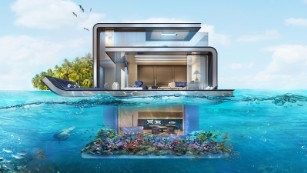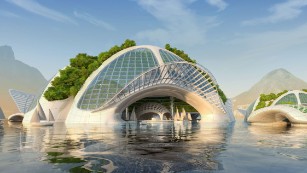What an incredible idea? Do you agree?
Think about the physical changes this concept brings to our urban centers and lives.
Living on water: Are waterborne cities more resistant to climate change?
Story highlights
- Architect Jason Pomeroy advocates building waterborne cities to cope with growing urbanization
- He says these developments are more capable of withstanding rising sea levels and natural disasters
(CNN)By the year 2050 about 70% of the world's population of 10 billion people will be living in cities, according to the United Nations.
The question is, will there be enough land to go around?
Not according to Jason Pomeroy -- founder of Singapore-based green architecture firm Pomeroy Studio -- who believes that due to climate change and rising sea levels, humans will be forced to build on water.
"Water
accounts for two thirds of the Earth's surface," he tells CNN. "We need
to think about new methods of urbanizing to accommodate population
growth."
Not only will waterborne
communities solve problems of inner-city densification and be energy
efficient, Pomeroy believes they could be flood, earthquake and weather
proof.
Liquid dreams
The notion of living on water isn't an entirely new one.
As Pomeroy notes in his new book, Pod Off-Grid: Exploration into Low Energy Waterborne Communities, people in Venice, Italy, and at the Bangkok Floating Market, in Thailand, have been doing it for centuries.
At
Chong Khneas floating village in Cambodia, schools, a church, shops,
homes and even a basketball court are all built on water.
What
Pomeroy suggests, however, is creating floating communities of
self-contained futuristic-looking pods, which create their own energy.
It's an idea he's already experimented with.
In
2009, at the former charcoal-producing town of Port Dickson in
Malaysia, Pomeroy created a floating development of 522 pod-homes in the
shape of a hibiscus -- the country's national flower.
"The
original intent was that each pod -- or house -- at Lexis Hibiscus
would create its own energy using solar technology and there would be a
water desalination device."
It's a goal his team are still working towards.
Weathering the storm?
Floating
structures that lack concrete foundations and which are exposed to the
elements might seem more vulnerable to natural disasters.
But Pomeroy says the opposite is true.
"Cities
are often located near water and therefore at risk of flooding," he
says. "Static buildings made from bricks and mortar are almost totally
unable to respond to climate change.
"But
if your development can react and move according to the rising or
settling of the tide it provides greater opportunity for protection."
It's a change that Pomeroy believes could save cities million of dollars.
"Hurricane Sandy in New York in 2012 resulted in a $25 billion bill for the insurance industry," he adds.
The Netherlands is already experimenting with floating communities that can rise or fall with the ride.
The Ijburg neighbourhood of Amsterdam
is home to a community of 75 multistory "houseboats" -- that look
nothing like boats -- supported by buoyant underwater concrete tubs.
Each home is anchored to steel mooring poles to stop them drifting away.
Also a catalyst for urban regeneration
Thanks
to technological advances in the past 50 years, the importance of a
Central Business District has diminished, says Pomeroy.
"Once
upon a time, cities were made for trade and commerce. Now we're in the
age of tech -- the hubs of a city don't need to be in the center
anymore," he says.
In this sense, waterborne developments can be a catalyst for regeneration.
"In
London, what we're seeing is the regeneration of old dock areas -- the
Royal Docks had its hey day during the Victoria era, but then in recent
years fell into decline.
"Now we're
seeing ideas about how to regenerate that space as a live, work and
play area, comprised of floating platforms on water."
Water, in this situation, really is a life source.



No comments:
Post a Comment